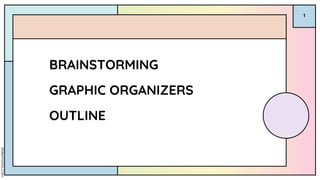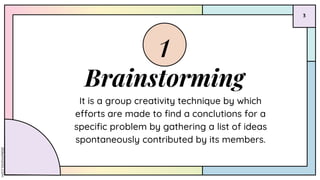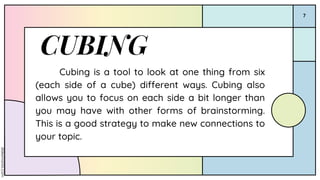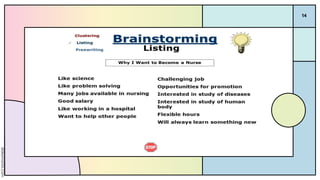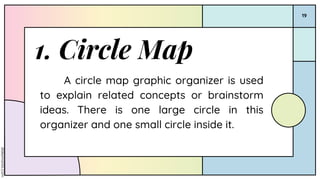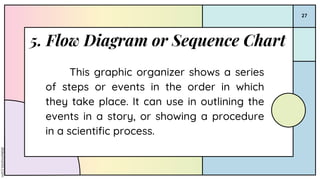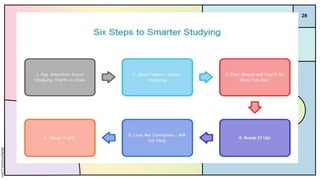BRAINSTORMING.pptx
- 2. Objectives: The students will be able to: 1. explain the techniques in organizing information. 2. identify the four basic techniques in organizing information. 3. realize the importance of organizing information. 2
- 3. It is a group creativity technique by which efforts are made to find a conclutions for a specific problem by gathering a list of ideas spontaneously contributed by its members. Brainstorming 1 3
- 4. Did you know? The term âbrainstormingâ was popularized by ALEX FAICKNEY OSBORN in the 1953 book Applied Imagination. He developed this technique when he got frustrated that his employees could not come up with useful techniques as they worked individually. 4
- 5. Brainstroming is resorted when: â there is a need for new ideas and when there is a problem to be solved. â in terms of writing: it is useful when a person has too few ideas or has too many and she us confused as to what topic to choose. 5
- 6. Four Brainstorming tips suggested by Mark Nichol in Daily Writing Tips. â Irene M. Pepperberg 6
- 7. CUBING Cubing is a tool to look at one thing from six (each side of a cube) different ways. Cubing also allows you to focus on each side a bit longer than you may have with other forms of brainstorming. This is a good strategy to make new connections to your topic. 7
- 8. Use these six starters to develop ideas about your topic. It may lead you to develop a strong topic. â Describe it. â Compare it. â Associate it. â Analyze it. â Apply it. â Argue for and against it. 8
- 9. DOG DESCRIBE IT COMPARE IT ASSOCIATE IT âĒ Dogs are mammals âĒ They are a variety of shapes âĒ They can be a variety of colors âĒ Some are bred to be hunters âĒ Some dogs are used in professional aspects âĒ Dogs can be loyal â Dogs are similar to wolves â Dogs differ from their ancestors in their instinct and playfulness â Dogs are known to mimic their owners â We associate dogs as man's best friend â Loyal â Playful â Lovable â Instinctive 9
- 10. âĒDogs are necessary in many professions âĒDogs are essential for happiness in families âĒDogs make life more enjoyable âĒDogs are great for therapy âĒDogs cause more harm than they're worth âĒDogs aren't as loyal as cats DOG ANALYZE IT APPLY IT ARGUE FOR OR AGAINST IT âĒ What makes a good dog? âĒ What makes a dog a good pet? âĒ What makes a dog a good training dog? â Dogs are a distant relative of a wolf and use similar instincts and loyalty traits â Dogs are used in multiple facets of life 10
- 11. FREE WRITING In this technique, just keep on writing and not minding errors in spelling or grammar. The objective here is to write what comes to your mind. Then review what you have written later. 11
- 12. 12
- 13. LISTING Listing is a brainstorming technique many people find useful. It means doing just what its name suggests -- listing possible topics and then sub lists of things you could say about each topic. 13
- 14. 14
- 15. MAPPING It also known as clustering and webbing, is a graphic form of listing that simply jotting down ideas on a large writing and then making connections by associating similarly themed ideas. 15
- 16. 16
- 17. It is a communication tool that uses visual symbols to express knowledge, concepts, thoughts, or ideas, and the relationship between them. Its main purpose is to provide visual aid to facilitate learning and instruction. Graphic Oraganizers 2 17
- 18. TYPES OF GRAPHIC ORGANIZERS â Irene M. Pepperberg 18
- 19. 1. Circle Map A circle map graphic organizer is used to explain related concepts or brainstorm ideas. There is one large circle in this organizer and one small circle inside it. 19
- 20. 20
- 21. 2. Spider Map This graphic organizer comes in handy when explaining things with descriptive connections. This organizer looks like a spider web, so itâs called a spider map. 21
- 22. 22
- 23. 3. Venn Diagram This diagram helps explain the differences and similarities between the two concepts. In this graphic, two large circles are created, intersecting each other at a point where you will mention the main topic of the study. 23
- 24. 24
- 25. 4. Tree Chart The classic tree chart is the perfect graphic organizer for categorizing and subcategorizing a topic into several sections. Using this chart, you can present extensive information in small sections for easy interpretation. 25
- 26. 26
- 27. 5. Flow Diagram or Sequence Chart This graphic organizer shows a series of steps or events in the order in which they take place. It can use in outlining the events in a story, or showing a procedure in a scientific process. 27
- 28. 28
- 29. It is the general plan of what you intend to write. Outline 3 29
- 30. TYPES OF OUTLINE â Irene M. Pepperberg 30
- 31. TOPIC OUTLINE 31 A topic outline allows writers to organize the topics of a paper quickly without going into details.
- 32. SENTENCE OUTLINE 32 All the headings are expressed in complete sentences.
